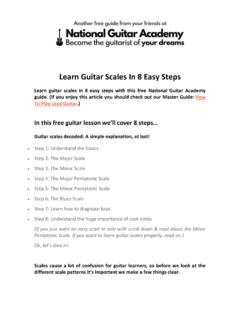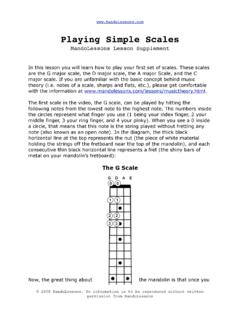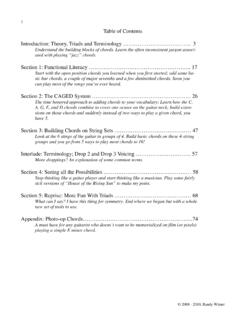Transcription of Guitar Notes Explained
1 Guitar Notes Explained : A Guide For Beginners Guitar Notes are at the heart of everything a guitarist does. They are the building blocks we use to play all chords, riffs & solos. In this GuitarFire guide you will learn: The Guitar string Notes The difference between Guitar Notes and Guitar chords. The musical alphabet The difference between sharps and flats 3 useful theory tips to help you navigate the fretboard fast Let s dive straight in! . Guitar String Notes (Standard Tuning) In standard tuning these are the open string Guitar Notes : This is the way most guitars are tuned. There are other ways to a tune a Guitar that change the Guitar Notes , but it s best to avoid alternate tunings while you re a beginner.
2 Stick with standard tuning for at least the first 6 months of your Guitar journey. If you switch to an exotic alternate Guitar tuning, the chord shapes all change. That s not much fun for a beginner. Let s keep things nice and simple! There are six strings on a Guitar . Each string has a name AND a number. The thickest string is called the 6th string. In standard Guitar tuning, this is tuned to E. We often refer to this as the low E string . This is the deepest/lowest Guitar note you can play. The 5th string is tuned to A, so it s usually referred to as the A string. The 4th string is tuned to D, so it s usually referred to as the D string. The 3rd string is tuned to G, so it s usually referred to as the G string.
3 The 2nd string is tuned to B, so it s usually referred to as the B string. The 1st string is tuned to E. This is the thinnest of all the strings. We often refer to this as the high E string . How to remember the Guitar string Notes The easiest way to remember the Guitar string Notes is to use a mnemonic: Elephants And Donkeys Grow Big Ears Or my personal Eddie Ate Dynamite Good Bye Eddie Kaboom! Try and make a mnemonic yourself. (The sillier it is the better; that will make it more memorable.) QUICK TIP These Notes are exactly the same on acoustic, electric, classical and semi-acoustic guitars. What s the difference between Guitar Notes and Guitar chords?
4 Notes are the smallest unit of musical language. We group Notes together to form chords. Some of our students find this analogy helpful: Notes are like letters. Chords are like words. To form a chord, we need to group some Notes together. Let s look at some examples: Notes Guitar Notes are individual pitches. Chords A chord is made when we stack Guitar Notes together and play them all at the same time. The chord has a larger and fuller sound because we hear several Guitar Notes played at the same time. Don t make this common beginner mistake! One of the worst mistakes you can make as a beginner guitarist is to try and learn all the Guitar Notes on the fretboard . In my experience (20,000+ hours teaching Guitar beginners) it s totally overwhelming for Guitar learners who take this approach.
5 All your energy as a new guitarist should be focussed on chords. Objectively, this is a more successful approach. I think this is because it s easier and more fun to learn some static chord shapes and immediately begin making music. So learn a few simple chords and get strumming; You can master your fretboard s DNA at a later point. Eventually everyone graduates to focussing more on Guitar Notes , scales and theory , but you should NOT start there. (If you do you will make slower progress and your Guitar journey will be more difficult than it needs to be. You will also become a very lop-sided guitarist.) Quick Tip Focus exclusively on chords and strumming during the first 3-5 months of your Guitar journey.
6 Guitar Notes : Exploring The fretboard We re going to move on now and explore the fretboard in greater depth. This is NOT essential knowledge for an absolute Guitar beginner, but it will deepen your understanding of the instrument if you want to learn more. Read on only if you want to learn more about the musical alphabet and how Guitar Notes lay across the fretboard . There s useful stuff here, but I don t want to overload you if you re new to the instrument. Understanding Guitar Notes & the musical alphabet Guitar Notes are the same as violin Notes and piano Notes . (The musical alphabet is the same across all instruments.) I ve always found it a bit odd how many musicians don t know their musical alphabet.
7 After all, the normal alphabet has 26 letters and the musical alphabet only has 12 Notes . The normal alphabet goes from A to Z. The musical alphabet goes from A to G. However, we have to remember our sharps and flats which appear between most (though not all) of the letters. The musical alphabet (and hence, order of Guitar Notes ) looks like this: A, A#, B, C, C#, D, D#, E, F, F#, G, G#, A. Quick Tip The # symbol means sharp . So you pronounce A# as A sharp . Sharps vs flats Sharps and flats are the same thing, just looked at from a different angle. We can describe all sharps as flats. If we do, the musical alphabet looks like this: A, Bb, B, C, Db, D, Eb, E, F, Gb, G, Ab, A. We use the b sign to denote flat.
8 So A sharp (A#) can also be called B flat (written as Bb). A# and Bb are the same note. If it were in the morning you could say it was half past nine or your could say it was 30 minutes to ten . Both descriptions would be accurate and both describe the same thing. Once again: A# and Bb are the same note. The same goes for the other sharps. C# (AKA C sharp ) is the same note as Db (AKA D flat ). D# is the same note as Eb. F# is the same note as Gb. G# is the same note as Ab. So we can write all the Guitar Notes like this (with sharps): A, A#, B, C, C#, D, D#, E, F, F#, G, G#, A. Or like this (with flats): A, Bb, B, C, Db, D, Eb, E, F, Gb, G, Ab, A. In reality, you will often see a blend of both.
9 Like this: A, Bb, B, C, C#, D, Eb, E, F, F#, G, G#, A. Do all Guitar Notes have a sharp or flat? No. Let s use this pattern to explain. (We re going to stick with all sharps to make this easier to understand.) A, A#, B, C, C#, D, D#, E, F, F#, G, G#, A. You may notice that not all the letters have a sharp between them. We go straight from B to C. There is no B# or Cb in-between. We go straight from E to F. There is no E# or Fb in-between. In music, there is no B#/Cb or E#/Fb. They don t exist.. How to memorise the musical alphabet Each fret has a number and it goes up one by one as we ascend the fret board: If we pluck a string without fretting any Notes we say that we re playing an open string.
10 We think of this as zero. An open string = 0 From 0, when we go up the fretboard , we re heading towards the body of the Guitar , like this: We say we re travelling up because the pitch of the Notes goes higher. How to practice the Notes of the musical alphabet The best way to practice the musical alphabet on a Guitar is to start on the open A string (5th string) and count up one fret at a time, naming the Notes as you go until you get to the 12th fret (the one with two dots on it): Start by plucking the open 5th string and you will hear an A note. Then press on the first fret on the 5th string and pluck. You will hear an A# note. Keep going. This is the full order you will hear from the open string all the way to the 12th fret: A, A#, B, C, C#, D, D#, E, F, F#, G, G#, A.














